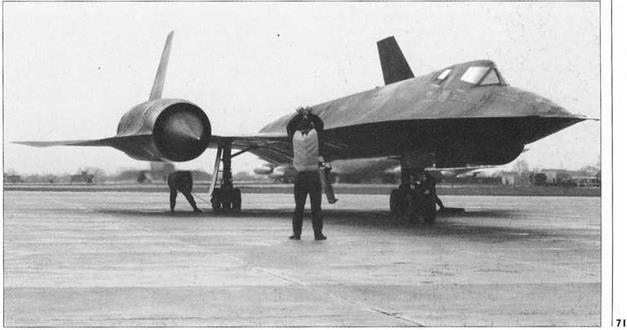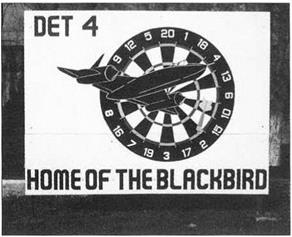Operations from the USA
Rolling down Beale’s runway 14, in ‘977, on October 1968, new pilot/RSO team Majs Abe Kardong and Jim Kogler were approaching VI when a wheel failed, throwing shrapnel into the fuel cells and causing a fuel fire. Abe aborted take-off at high speed, causing the remaining tyres on that leg to burst. The brake ’chute blossomed only to be consumed immediately by the fire. With one wing low and the aircraft off-centre to the runway, ’977’s sharp inlet spike knifed through the barrier cable at the end of the runway, rendering it useless. Now on the overrun, Jim ejected while Abe rode out the highspeed sleigh ride. When the dust settled, he was helped from the cockpit by the Mobile Control crew for that day, Willie Lawson and Gil Martinez. Despite four 9th SRW aircraft losses between 13 April 1967 and 10 October 1968, Category III ‘Operational’ Testing ended in December 1968 and the wing was awarded the Presidential Unit Citation for meeting the challenges of bringing the most advanced reconnaissance system of its day to operational readiness.
![]() On 11 April 1969, Lt Col Bill Skliar and Maj Noel Warner lost SR-71A, 64-17953 on the Edwards runway
On 11 April 1969, Lt Col Bill Skliar and Maj Noel Warner lost SR-71A, 64-17953 on the Edwards runway
following an incident similar to the loss of ‘977. ‘Dutch 69’ had just rotated when one of the left main gear tyres blew. With the aircraft at max gross weight, the other two tyres on that leg also blew. Bill aborted the take-off, but red hot shrapnel from the disintegrating wheel hubs punctured the fuel tanks and triggered a fire which engulfed the entire aircraft. Once at a standstill Bill exited the aircraft to the right and assisted Noel from his rear cockpit. ‘953 never flew again and after this accident the Goodrich tyres were ‘beefed up’.
A third pitch-up accident happened on 18 December 1969, when Director of the Test Force, Lt Col Joe Rogers and RSO Lt Col Gary Heidelbaugh were accelerating and climbing ‘953. They heard a loud explosion which was accompanied by a loss of power and severe
Above Darrell Greenamyer and Steve Belgau first flew the ‘Big Tail’ conversion of 17959 on I I December 1975.The redesign increased reconnaissance gathering capacity but was not pursued on the operational fleet. (Paul Crickmore Collection)
Left The last operational SR-71 to be lost was 17974 on 21 April 1989. Pilot Maj Dan House and his RSO Capt Blair Bozek ejected safely. (Paul Crickmore Collection)
Right Detachment 4 (Det 4) of the 9th SRW was created at RAF Mildenhall on I April 1979. (Paul Crickmore)
Bottom right Another Det 4 sortie gets underway. (Paul Crickmore)
control difficulties. As the aircraft decelerated, its angle of attack continued to increase, despite Joe ‘firewalling’ the control stick. Realising they’d entered an irrecoverable corner of the flight envelope, ten seconds after the explosion, Joe ordered “Let’s get out Gary” and both men safely ejected; ‘953 crashed at the Southern end of Death Valley. The cause of the explosion remains unknown.
On 17 June 1970, the 9th lost another SR-71A, serial ‘970, following a mid-air collision with a KC-135Qshortly after taking aboard 35,000 lbs of fuel. The Habu hit clear air turbulence (CAT) and the entire nose of the aircraft smashed into the rear of the tanker. No one aboard the tanker was injured and Buddy Brown and Mort Jarvis were able to eject safely – although the former sustained two broken legs during the ejection.
At MOOhrs on 6 October 1973, Syrian and Egyptian artillery barrages on the state of Israel spelled the beginning of the Yom Kippur War. With Israel caught off guard, the Arabs made substantial gains both in the Sinai and the Golan Heights. In view of the grave situation faced by Israel, the US decided to step up intelligence efforts and used the SR-71 to provide a hot-spot reconnaissance capability. CINC SAC General John Meyer ordered Col Pat Halloran (9th SRW Commander) to prepare for missions that would be flown from Beale
across the war zone and recover into RAF Mildenhall, England. However, the Heath government denied the SR – 71’s use of Mildenhall in a move designed to safeguard the supply of Arab oil to the United Kingdom.
Instead, round-robin missions would be flown from GrifFiss AFB, New York; accordingly, two SR-71As, ‘979 and ‘964, were despatched to the east coast air base where they arrived on 12 October. At 0600 a secure teleprinter clattered out details of the first sortie which was to be flown just 22 hours later. The belligerent attitude of usually helpful allies necessitated that JP 7 fuel and tanker crews be re-positioned from Mildenhall and Turkey to Zargoza in Spain and emergency landing sites were proving all but impossible to find. Nevertheless, Jim Shelton cranked ’979’s engines on cue and lifted off from Griffiss and headed east at 0200hrs. Just off the east coast he made good the first of many ARCP’s (Air Refuelling Contact Points), he topped-off and continued east to the
|
|
next cell of tankers awaiting the thirsty Habu just beyond the Azores. Returning again to speed and altitude they made a high-Mach dash through the Straits of Gibraltar and let-down for a third air refuelling just east of the heel of Italy. Due to its proximity to the war zone and Libya, the US Navy provided a CAP (Combat Air Patrol), from carrier-based aircraft on station in the Mediterranean. They then climbed and accelerated to coast-in over Port Said. Gary Coleman, the RSO: “There was no indication that anything launched against us, but everyone was painting us on their radars as we made our turn inbound. The DEF panel lit up like a pin-ball machine and I said to Jim, ‘this should be interesting.’”
In all ‘979 spent 25 minutes over ‘denied territory’. Entering Egyptian airspace at 1103 GMT, they covered the Israeli battle fronts with both Egypt and Syria before coasting out and letting down towards their fourth ARCP, which was still being capped by the US Navy. Their next hot leg was punctuated by a fifth refuelling, again near the Azores, before a final high-speed run across the western Atlantic towards New’ York. Mindful of his own fatigue, Gary was in awe of his pilot who completed a text book sixth air refuelling, before greasing ‘979 back down at Griffiss after a combat sortie lasting ten hours eighteen minutes (more than five hours of which was at Mach 3 or above) and involving eleven tanking operations from the ever dependable KC-135Qs Their reconnaissance ‘take’ was of high quality and provided intelligence and defense analysts with much needed information concerning the deposition of Arab forces in the region, which was then made available to the Israelis.
 |
Aircraft ‘979 paid a second successful visit to the Yom Kippur war zone on 25 October, this time being crewed by Majs Al Joerz and John Fuller. A third mission was chalked up by the same aircraft eight days later. Majs Jim Wilson and Bruce Douglas took’ 964 on its first sortie to the Mediterranean on 11 November. The ten hour 49-
![]() minute flight departed Griffiss and terminated as planned at Seymour Johnson AFB, North Carolina, where the detachment had migrated to avoid the New York winter weather.
minute flight departed Griffiss and terminated as planned at Seymour Johnson AFB, North Carolina, where the detachment had migrated to avoid the New York winter weather.
Despite hostilities between the factions officially ending with a Soviet-backed motion in the United Nations on 24 October, fierce fire-fighting continue to break out at regular intervals and it was to cover disengagement that the SR-71’s monitoring system continued to be called upon, with five further marathon flights being flown from Seymour Johnson AFB.
In total, these nine flights represent a pinnacle of operational professionalism and serve as a tribute, not only to the dedication of the aircrews, but also to that of the staff planners, tanker crews and of course the unsung heroes, that small group of top ground technicians who maintained the SR-71s away from home. The sorties also stand as a testament to the long-reach capability of the aircraft and its ability to operate, on short notice, with impunity in a high threat environment.











